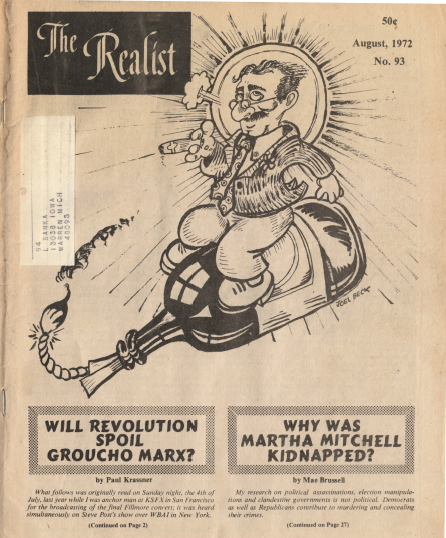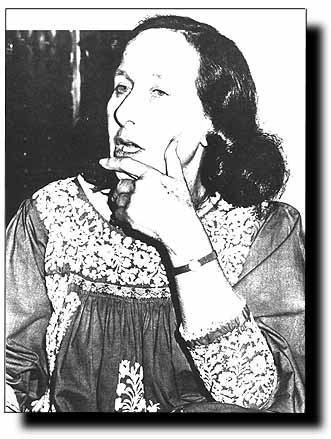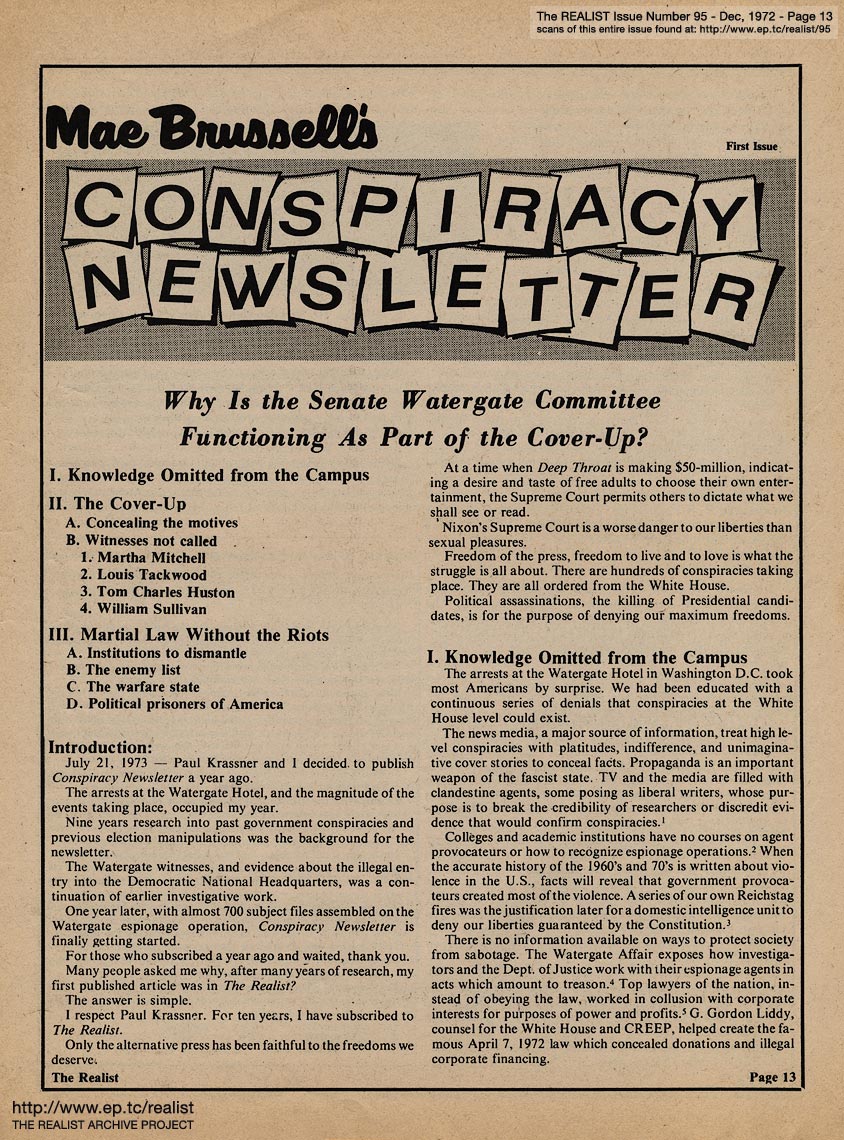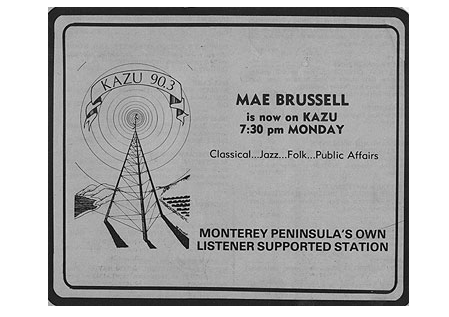SIDEBAR: The Quotable Mae Brussell
By Joe Livernois
The truth is packed away in 39 four-drawer file cabinets. Those folders could hold the secrets to the Kennedy killings, the fascists behind Watergate, and the untimely deaths of John Lennon, Freddie Prinze Jr. and John Belushi. Mae Brussell had meticulously pieced together the evidence. Reports, clippings, hints and allegations. The truth can be found in those files, wherever they are.
But that’s not all. Somewhere packed away in all those files may be letters Brussell collected from Henry Miller. Maybe. Where else would those letters be, if they actually exist? Were they love letters? No one will ever know until the files are found. They are missing, lost to the ages.
Mae Brussell was the Queen of Conspiracy, the Doyenne of Intrigue. And she was perhaps one of the most enigmatic characters from Monterey County to ever rise to national prominence. She was that voice on the radio — delivering inconvenient truth in straight incontrovertible monotone late on a Sunday night. But she was also the exemplar of maternal domesticity, driving her five kids to dance recitals and music lessons, cooking dinner every night and incubating a devotion to art and music that still sustains her surviving brood.
“Our house was filled with hearts and angels and beautiful art,” says Barbara Brussell Fessler of Pacific Grove. “Our house was filled with love. And all those files.”

I met Barbara Brussell Fessler, Mae’s eldest daughter, at a restaurant in Carmel on what would have been her mother’s 96th birthday. Barbara Brussell is a cabaret singer who spent decades in New York City before returning to Monterey County several years ago. She is the only Brussell survivor still living in Monterey Country and she happily admits that she frames her perspective about life in show tunes.
I didn’t know Mae Brussell. I had heard her radio show, on KLRB and later on KAZU, and I was aware of her reputation. I admit that I was dismissive. Maybe because she seemed far-fetched, or maybe because my orderly existence desperately needed to believe she was wrong. In any case, and in retrospect, I wish I had known her, or at least paid closer attention.
Because, really, if only Mae Brussell could be around today, to explain the connections during this era of Trump and Hillary.
Barbara Brussell Fessler isn’t really as interested in that as much as she would love to know where those files went. They seem to have disappeared into some conspiratorial black hole. Thirty years later, the would-be scholars and keepers of the flame spend most of their days sniping at one another, but Barbara has no idea if any of them has the files.
I suppose they are like termites gnawing away at the foundation. How do you know who to trust?
***
How do you know who to trust?
That goes to the heart of Mae Brussell’s legacy. It’s a question she’d be asking today.
If anyone could have found the direct link between President Donald J. Trump and Gen. Reinhard Gehlen, Adolf Hitler’s chief intelligence officer against the Soviet Union, it was Mae Brussell. After years of research, Brussell argued that all the bad mojo in America started when Gehlen was smuggled into the United States three months after Germany surrendered in 1945. In Brussell’s world, there are no coincidences. Particles do not collide randomly. Nothing in the world that matters can happen without devious pre-operational planning involving shadowy figures, working in darkness, who are pulling the strings.
Over two decades, the memorable coordinates along the Brussell line of conspiracy included the Cold War, Roy Cohn, the Kennedy’ assassinations (John and Robert), Jack Ruby, Chappaquiddick, Patty Hearst, Kent State, J. Edgar Hoover, Charles Manson, the assassination attempt on Cesar Chavez, the FBI, Watergate, high-profile heroin “overdoses,” Mark David Chapman and Oliver North. There would have been more, certainly, as events unfolded after 1988, after Mae Brussell died of cancer at the age of 66. But no one since has been able to explain the singular interconnectivity of world events better than Mae Brussell. And Trump would have certainly been implicated in it all.
Mae Brussell was the Queen of Conspiracy, the Doyenne of Intrigue. And she was perhaps one of the most enigmatic characters from Monterey County to ever rise to national prominence.
Mae Brussell may have come as close to credible as it gets in the eccentric, murky world of conspiracy theorists. People who dismissed her as just another kook weren’t paying attention. They didn’t know who she was and they didn’t appreciate her deep research.
She liked to tell everyone she was just a housewife, but there was more to her than that. She was a great-granddaughter of the I. Magnin department store founder. Her father, Edgar Magnin, was sort of famous at the Wilshire Boulevard Temple, where he was known as the Rabbi to the Stars. He was the presiding rabbi at Irving Thalberg’s marriage to Norma Shearer. The family mingled with the Hollywood elite. Edgar rode bicycles with Einstein whenever Einstein was in town. Mae once compared her life-before-conspiracies to “The Garden of the Finzi-Continis,” the 1970 Italian film that depicted Jewish aristocrats living on an idyllic estate.
She was a philosophy major at Stanford who dropped out 10 weeks before graduation to get married. She had two sons, got a divorce, remarried and had three daughters. She lived the quiet life for a bit. They lived next door to Lloyd Bridges, of “Sea Hunt” and “Airplane!” fame, and they are still friendly with the kids. (Barbara’s brother, John Goodwin of Nashville, writes songs for Jeff Bridges.) Things changed on November 22, 1963, after the motorcade rolled through Dealey Plaza in Dallas.
 The JFK assassination may have changed every American who was alive at the time, but Mae Brussell got obsessive about the facts of the matter. Nothing could be that random. What did Lee Harvey say about being a patsy? And who was this Jack Ruby character, really? In fact, it was the Jack Ruby character that really set her off. “We were watching that on TV, on a Sunday, Jack Ruby killing Lee Harvey Oswald,” Barbara Brussell says, “and I remember my mother saying, ‘This is a conspiracy.’”
The JFK assassination may have changed every American who was alive at the time, but Mae Brussell got obsessive about the facts of the matter. Nothing could be that random. What did Lee Harvey say about being a patsy? And who was this Jack Ruby character, really? In fact, it was the Jack Ruby character that really set her off. “We were watching that on TV, on a Sunday, Jack Ruby killing Lee Harvey Oswald,” Barbara Brussell says, “and I remember my mother saying, ‘This is a conspiracy.’”
Mae Brussell purchased all 26 volumes of the Warren Commission Report, a Christmas gift to herself, and combed through each page for traces of evidentiary inconsistencies in their investigation of the JFK assassination. She gathered facts from hundreds of other sources. She was an inveterate newspaper clipper.
“It became a line in the sand,” Barbara says. “If you really believed that Lee Harvey Oswald acted alone, she could no longer be your friend. It became her litmus test. It was that black and white for her.” Mae divorced again, and moved the family to Carmel Valley in 1965.
Mae Brussell could spin improbable stories with such unvarnished calm that it was easy to believe most of it was true. To listen to her was like sitting in on a Garden Club presentation about daffodils, except with considerably more twists, turns, fascists and murders. “She could talk for hours straight, never dropping a stitch and barely taking a breath,” remembers Luana Conley, an activist from Carmel Valley.
Brussell’s integrity was such that she taught an accredited course about conspiracy at Monterey Peninsula College in the 1970s.
She also wrote articles that were picked up by the more liberal publications and by some of the soft-porn magazines that were popular at the time. She was championed and promoted by alternative media mavens of the era, especially by Paul Krassner, who carried much of her work in his publication, The Realist, and who wrote about her admiringly and extensively. Krassner (who famously claimed to have dropped acid with Groucho Marx and wrote about it) was the first to refer to Mae Brussell as the Queen of Conspiracy. He also referred to her as a “Bionic Researcher.”
“She is plump and energetic,” Krassner wrote in a profile of Mae Brussell for Oui magazine (one of those Penthouse spinoffs). “She wears long peasant dresses patchworked with philosophical tidbits, and her favorite adjective is ‘cute.’ Occasionally, she slurs her words—information overload—but her eyes seem to reveal the deep sense of compassion permeating every fact she shares. One senses a touch of appropriate incongruity about this white, upper-middle-class, twice-divorced mother of a talented brood, who is knitting a sleeve while calmly describing the architecture of a police state in progress.”
She hit the big time with her radio show, “Dialogue: Conspiracy.”
The weekly one-hour show was broadcast on Sundays on KLRB-FM, Monterey’s legendary rock-and-roll station. Its reach was originally confined to the Monterey Bay region. But then Watergate hit and conspiracy theories became a cottage industry, for which she was uniquely situated. Her program got picked up by about a half-dozen radio stations across the country, and Brussell’s dry, matter-of-fact voice filled the airwaves from Syracuse to Seattle.
As her fame grew, Brussell changed the name of her radio show to “World Watchers International.”
In 1972, Krassner started publishing and distributing Brussell’s twice-monthly newsletter, called Conspiracy Newsletter. The newsletter was funded with a $5,000 gift from John Lennon and Yoko Ono, who were friends of Krassner. They loved what Brussell was doing and invited her to meet them when they were in San Francisco. Brussell packed her blue Saab with kids for the trip up to San Francisco, where the family spent the day holed up in a hotel room with John and Yoko.
“She is some kind of saint, and truthseeking is her discipline,” Krassner wrote when announcing his partnership with Brussell. “Knowing her, I’ve undergone a religious conversion: from believing in Coincidence to believing in Conspiracy.
“And remember, even if Paul Revere could’ve been diagnosed as a raving paranoid schizophrenic, it doesn’t mean the British weren’t coming.”
***
Mae Brussell died 30 years ago in October, after a bout with cancer, but her legacy is still being kicked about.
Late last year, for instance, the producers of the Slow Burn podcast about Watergate devoted an entire episode to conspiracy theories spawned by Richard Nixon. That episode naturally starred Brussell. Among other things, Brussell was convinced that the airline crash that killed E. Howard Hunt’s wife was an inside job. Hunt had been a CIA officer and his fingerprints were all over the Watergate scandal; his wife, Dorothy, was suspiciously carrying $10,000 in sequentially numbered $100 bills when the plane went down. Brussell managed to piece together Dorothy Hunt’s movements in the hours before the crash. As Brussell spins the yarn, it is obvious that Dorothy Hunt was murdered, and that the 42 other people on the plane (and two on the ground) were collateral damage.
Mae Brussell could spin improbable stories with such unvarnished calm that it was easy to believe most of it was true.
Earlier this year, The Daily Beast wrote a profile of Brussell that likely would have sickened her. That story suggested that she was a forerunner to Alex Jones, the raving loudmouth who hosts Info Wars.
In 2014, a fan released The Essential Mae Brussell: Investigations of Fascism in America, a 378-page volume. It’s a best-of-Mae-Brussell, so to speak, with a forward by Krassner.
There’s a maebrussell.com site, of course, but it has a crude pre-Wordpress design. The banner headline on the Mae Brussell Website is a link to cautionary information about fluoride. The site also markets a package of Mae Brussell stuff, including 750 hours of her radio broadcasts and a two-hour film documentary called Mae Brussell in Santa Cruz. The film, released in 2006, is mostly Brussell’s presentation to an audience at UC Santa Cruz in 1987.
One of the better Brussell-related sites is called www.worldwatchers.info, which offers free access to the largest collection of Brussell’s radio episodes.
And no collection of conspiracy theorists is complete without bitter rivalries among true believers. They call themselves Brussell Sprouts, and they like to claim that their Mae Brussell scholarship is superior to the others. They will all likely dismiss this story, for any number of convoluted but seemingly credible reasons, after analyzing it for traces of CIA influence. (Indeed, none of the anonymous operators of the better-known Brussell sites contacted for this story responded to email requests for interviews.)
Some people think of her as some sort of swami. A blogger running a site called “Suspicious Deaths” credits her with predicting the Peoples Temple massacre, Robert F. Kennedy’s assassination and the attempt on Ronald Reagan’s life in 1981.
And, of course, Mae Brussell is no stranger on reddit.com, where out-there theories, eccentric conspiracies and dark insinuations are the order of the day.
***
When he took the job at KLRB-FM, Matthew Arnett knew that his weekend shifts would include responsibility for producing Mae Brussell on Sundays. It was kind of a bummer for him, a rock deejay getting started in the business, because she interrupted his thing.
“On the other hand, she was the easiest person in the world to produce a show for,” Arnett says. “All she really needed to know was which microphone was on.”
By then, 1978, Brussell was kind of a big deal. Her show was all over the country, she was writing for all sorts of publications and she was the subject of occasional analytic profiles. “But she was very non-assuming,” Arnett says. “She didn’t have the ego that came with her notoriety. She was sort of like a librarian.”

The station was created by an insurance man from Salinas named Eddie Johnson, who knew nothing about radio but who understood that popular music was hip with the kids, according to David Bean, who worked with Brussell at KLRB for years. Johnson hired Robert Barron, from KDON, to serve as station manager. Barron and his wife Gloria were old friends and admirers of Brussell, so it made sense to bring her to the station to fulfill its Federal Communications Commission “public-service” obligations.
“It was always about ending the war,” Bean said. “We were an anti-war station and the focus or our music and our programming was all about that. It’s the reason Mae fit in so well.” In addition to Brussell, KLRB filled its FCC requirements with recorded lectures by Alan Watts, the British neo-Zen philosopher.
She really didn’t have a syndication deal with other stations, Bean said. Syndication wasn’t really a thing back then. Rather, on Monday mornings, she’d ship off tapes of the previous night’s show to radio stations throughout the country that she thought might air them. It was all free. They could run the program or not. Many of them did, particularly after Watergate broke, Bean said.
After a couple of years, after an inevitable change of ownership at KLRB and the inevitable “change of direction,” the inevitable suits decided that Brussell didn’t fit in. Bean said he believes the local business community pressured station management to tone down its progressive programming. Bean helped her get on KAZU, the community nonprofit radio. “It really was a much better fit over there anyway,” said Arnett.
***
Barbara Brussell says that she mostly remembers that her mother provided a lively, happy home. She was the coolest mom in town, dragging the kids to the Big Sur Festival, to the Monterey Pop Festival, to meet John and Yoko. They met Dick Gregory, the activist-comedian. They listened while their mother argued with Mark Lane, a more mainstream conspiracy buff. They thought it was cool that she knew Jim Garrison, the district attorney from Louisiana who promoted the conspiracy theories of JFK’s assassination.
She constantly shared what she was learning with her children at home.
Weird stuff started happening, starting in 1967. According to Barbara, Mae was returning from Louisiana after interviewing Garrison, when her plane was grounded due to a bomb scare. Her luggage went missing for a week. When it returned, the key documents she carried with her had been ruined, Barbara said, and it put her mother on high alert for the next 20 years.
Some of the weird stuff happened to the family, too personal to share even today, but they were the sorts of things that happen in every family. Mae usually found a way to attribute them to her work, explaining that she was getting too close to the truth and the government was sending messages to back off.
Then, late on a rainy evening on Dec. 15, 1970, Barbara Brussell and her younger sister, Bonnie, were in a VW microbus with several other Carmel High School students. They were returning from a field trip with a dance group at Cabrillo College. The van was being driven by their teacher, a 22-year-old. The van collided with another vehicle, which may have been stopped on the highway near Marina. The wreck killed the teacher and two students, including Bonnie Brussell. Bonnie was 14 at the time. Barbara, a year older, was in traction for months. Her legs had been crushed, and so were her dreams of being a professional dancer.
Naturally, Barbara Brussell says her mother couldn’t help but think that it wasn’t just an accident, that perhaps sinister forces were behind the accident. She agonized that her work might have led to her daughter’s death. It was a dark period for the entire family.
Mae Brussell was torn, worried about the safety of her family. But she kept up the research, kept up the reporting, and she became even more famous. Finally, in March of 1988, Mae put an end to the radio broadcasts after receiving a death threat by telephone. Much earlier in her career, she had received a threatening letter from Sandra Good, a Manson family member, and she had installed about $3,000 worth of security devices around her home, but the 1988 call scared her enough that she called it quits. “I pushed my luck for 17 years on the air,” she told listeners on her final broadcast.
Seven months later, Mae died of cancer. The Brussell Sprouts suspected the worst; they circulated the theory that agents had her killed. They noted that the house across the street in Carmel Valley, which Brussell had always suspected of being occupied by government agents, burned to the ground the night she died.
In any case, she left a loving family … and 39 file cabinets filled with clippings, research, hints and innuendoes. An estimated 6,000 books. And maybe love letters from Henry Miller. Barbara Brussell would love to know where they are.

Before she died, Mae designated her library to John Judge, a trusted collaborator who eventually died, to create the Mae Brussell Research Center. The files got turned over somehow to a guy who owned a bookstore in Santa Cruz, and he was going to establish a Mae Brussell Research Center somewhere. What happened next gets fuzzy. Another Santa Cruz woman may have got her hands on the files and no one has seen them since. They were going to be donated to Stanford University but that fell through. Then there was talk of a donation to a JFK research center at Baylor University in Waco, Texas, but that didn’t happen either. The woman wouldn’t release the files to the family, and everyone lost track of what happened to them.
In 1992, the Santa Cruz Sentinel reported the controversy over the Mae Brussell Research Center. The principals at the time — the Brussell Sprouts — all accused one another of killing the deal, proffering wild allegations and damning insinuations. “Every conspiracy theorist thinks every other conspiracy theorist is part of the conspiracy,” noted Jonathan Vankin, a San Jose author who wrote about conspiracies, including what happened to the proposed research center.
***
Barbara says she loves her memories of her mother and she is proud of what she was able to uncover. She still tries to make sense of her mother’s work and of the whole mother-daughter relationship thing.
And when she ponders whether any of it is true — her memories, her mother’s work — she says she reverts to a Stephen Sondheim song from The Pacific Overtures called “Someone in the Tree.”
In that song, an old man recalls the things he thinks he saw when he was a young man, sitting in the tree. It was important that the boy sat in the tree, because had he not been there, “who’s to say things would happen here the way that they happened here.” And the old man is stunned to learn that, years later, he may not have witnessed what he thought he had seen.
It’s the fragment, not the day.
It’s the pebble, not the stream.
It’s the ripple, not the sea
That is happening.
Not the building but the beam,
Not the garden but the stone,
Only cups of tea
And history
And someone in a tree.
Says Barbara Brussell: “Sometimes I think it’s my mother sitting in that tree. Sometimes I think it’s me, the next tree over, watching my mother.”
Letter: Mae Brussell remains an icon
Have something to say about this story? Send us a letter.